A small village with a lengthy history
Pre-history
Remains of Neolithic occupation 4300-2000BC, are evidenced by the remains of the hillforts and long barrows at Salperton Camp and Hazleton Long Barrows and by the now ploughed-up Turkdean Long Barrow at Leygore.1
First recorded settlement
Pottery remains from Turkdean Roman Villa indicate that the site was first settled by Roman occupiers around 150-200AD during the reigns of Marcus Aurelius and Commodus.2
Roman residence, garrison, trading post, temple
Roman and Romano-British use of the villa as a large residence, garrison and trading post between 180-400AD may have been supplemented by a religious purpose, suggested by the unusually large communal bath in the central range of the three courtyard villa and perhaps dedicated to Cuda, a “mother” goddess associated with the Cotswolds, its rivers and springs.3
Roman Withdrawal
The abundance of coins found from Valentinian’s reign (364-378AD) and the relative scarcity of coins from the reign of Theodosius (388-402AD) found at the villa suggest that the site may have been abandoned just prior to the date at which Flavius Claudius Constantinus (subsequently Constantine III) withdrew Roman forces from Britain.4
The early Dark Ages
After the Roman withdrawal the Cotswolds retained a British Dubonni tribal identity until the Battle of Dyrham in 577 at which the Saxons overran the Cotswolds. However, 50 years later, Penda, subsequently the Saxon King of Mercia, overcame the Hwicce tribe at the Battle of Cirencester in 628, incorporating the Cotswolds in to the Mercian territory.
Christian traditions take hold under Mercia
It has been suggested (not without caveats) that the Cotswolds remained a Christian sub-kingdom under relatively light supervision, rather than being entirely absorbed into pagan and Saxon Mercia during the Mercian supremacy in the Anglo-Saxon heptarchy 650-825AD when the area was controlled from Winchcombe, 11 miles to the North of Turkdean.5
Later Saxon development
Dubonni and Christian identity continued to mark the North Cotswolds through the late Saxon period as Mercian influence was replaced by the rule of Wessex. By the time of Edward the Confessor (1042-1066AD) Turkdean formally consisted of two manorial estates: ‘Upper Dean’ and ‘Lower Dean’ held by Saxon nobles including Osgot and Siward and administratively controlled as part of the Bradley Hundred.6
Norman control in a predominantly Saxon society
Twenty years after the Conquest, the Doomsday Book listed ‘Turchedene’ and recorded Robert d’Oilly, who had fought with William at Hastings and who had subsequently married the Saxon heiress Ealdgyth daughter of Wigod of Wallingford, as the Lord of the Upper Dean manorial estate. The d’Oilly family connection with Wallingford led Turkdean to be considered one of the manors of the Honour of Wallingford until transferred to the Honour of Ewelme in 1540. Meanwhile, down the hill, William Leofric, the Norman son-in-law of the previous Saxon Lord, Osgot, was recognised as the newly installed Lord of the Lower Dean manor.7 The combined manorial estates recorded some 40 residents at Doomsday in 1086.
Work commences on current church structure
The Norman knight Robert d’Oilly is usually credited with responsibility for starting work on the current site of Turkdean’s church in the late 11th century, originally dedicating the building to the Virgin Mary. More substantial work was then continued by the Norman “justiciar” Ralph Basset in the early years of the 12th century .
Church given to Osney Abbey
Robert d’Oilly the Younger, nephew of the previous Robert, gave the Church of St Mary at Turkdean to the house of Augustinian Canons at Osney in Oxford that he founded in 1129. 8
Chancel added
A Chancel was added to the East of the original Norman building and a Tower formed within the West end of what became the Nave, at which time a number of the Norman architectural features were reset within the “new” walls, including the upper portion of a “small Norman doorway with a roll moulding on cushion capitals, diapered tympanum, abaci and hoodmould with saltire crossed” leading to years of confusion and complication for architectural historians. 9
First recorded Vicar of Turkdean
Robert of Bourton became the first recorded Vicar of Turkdean appointed by Osney Abbey in 1289, towards the end of the reign of Edward I Longshanks.
Bell made by John of Gloucester hung
A “second” bell made by the master founder John of Gloucester was hung at All Saints in the first half of the 14th century. 10 The 26inch (66cm) bell, weighing 3cwt 2qr (165kg) is inscribed ETERNIS ANNIS RESONET CAMPANA IOHANNIS (“The bell will ring for years eternal.”) After a long period of disuse this ancient bell was brought back in to active regular use at Turkdean as part of the bell and tower restoration project completed in 2023. (For bell enthusiasts there is another John of Gloucester bell at St Bartholomew’s in our nextdoor parish of Notgrove.)
The Black Death in the Cotswolds
The plague of 1348 arrived in Britain in Weymouth and ripped through communities in the South-West. The population of Turkdean, which had been growing slowly through the 12th and 13th centuries fell back to its Doomsday level of 40 and portions of the 2,000acre parish fell out of cultivation.
North wall moved, South aisle added
The North wall of the nave was rebuilt in the late 14th or early 15th century and a South aisle added, presumably to accommodate population growth in the years following the Black Death 11 which also saw intensified sheep farming across the Wolds, although still under the open field system.
Transfer to Honour of Ewelme
Turkdean had been regarded as part of the large Honour of Wallingford from the time of Robert d’Oilly’s Lordship and ultimately therefore held by the Crown through the Duchy of Cornwall, but was transferred by 32 Hen. 8 c. 53, along with other manorial holdings, to the Honour of Ewelme in 1540.
Christ Church, Oxford era begins
After the Dissolution, the Crown granted the right of presentation to the parish of Turkdean, along with most livings within the Honour of Ewelme, to the Dean and Chapter of Christ Church, Oxford in 1542. This was then re-confirmed in 1546. The Christ Church link remained intact through the next four centuries, with the Rectory land let to successive tenants until the late 19th century.
Vicarage rebuilt
Vicarage house rebuilt by and for Rev Henry Massey.
Parliamentary Inclosure
Turkdean’s open fields were brought under Inclosure by the Turkdean (Gloucestershire) Inclosure Act 1792
(32 Geo. 3 c.21).
1859 “Biscoe” restoration
Rev Frederick Biscoe, Vicar of Turkdean 1837-1887, made substantial improvements at All Saints during his long tenure including the installation of a new and even floor, the removal of the seating gallery that had been installed in the West end, the old square highback pews were replaced by new lower pews, the flat ceilings removed and the Norman arch between Nave and Chancel restored.
1897 “Tudor” restoration
All Saints’ Vicar, Rev John Lechmere Tudor, organised a significant programme of repair and renovation with his architect cousin, Charles Lloyd Tudor 12 including the replacement of the roof, installation of new drainage, insertion of new and re-levelled wooden block floor and the movement of all the tombstones to the South Aisle (see plan.) During the course of these works the ancient altar stone which bears five simply inscribed crosses was found under the Western wall of the aisle and moved to reside under the altar. The form of this ancient altar stone gives some credence to the possibility that a Saxon church structure sat on this site before the Norman building.
Christ Church sells Rectory Farm
Christ Church had considerable difficulty in finding tenants for the Rectory Farm lands following the agricultural depression of the 1870’s and finally, in 1911, sold the Rectory Farm lands that they had held since 1542.
Tradition of resident priest ends
Following the retirement of Rev Marianus Hay as Vicar,
Christ Church sold the Vicarage and their remaining land holdings in Turkdean in 1948, merging the living of Turkdean with neighbouring Farmington. The newly appointed Vicar of Turkdean & Farmington, Rev Geoffrey Graham, thereafter took up residence in Farmington.
Parish separated from Farmington and joined with Notgrove and Cold Aston
Diocesan re-organisation encouraged Turkdean to break the tie with Farmington and instead join with Notgrove and Cold Aston. Rev James Hughes was appointed Vicar of all three parishes.
Disastrous redecoration removes murals
Amidst a programme of redecoration organised by the non-resident Priest, Rev James Hughes, the decorators found, but then washed away a “very fine late 13th century Madonna” as noted byWill Croome CBE FSA, who sent Eve Baker to inspect and advise, but who sadly arrived too late to save the murals. The ephemeral remains were subsequently over-painted, creating All Saints’ unintentionally simple current church interior . 13 14
All Saints joins new Northleach Benefice
The neighbouring parishes of Turkdean, Notgrove and Cold Aston were further merged with Hampnett, Hazleton, Farmington, Compton Abdale and Northleach in a newly formed 8-church Benefice sharing one Priest-in-Charge (and sometimes Rector) based in Northleach.
New Benefice Priest-in-Charge
Turkdean welcomed Rev Dr Alycia Timmis as the new Priest-in-Charge of the Benefice, succeeding Rev David Ford.
Bells repaired and rehung
All Saints’ four bells had been in declining health for many years with two cracked bells dismounted from the medieval wooden bell frame and set aside in the 1950s and only one bell capable of swing chiming. Following a successful appeal for funds in 2022, all four bells were taken down and sent away for repair and restoration and subsequently re-hung on a strengthened steel frame in 2023. The bells are now rung by an electronic remote control chiming mechanism.
- A fascinating study of the changing pattern of development of an adjacent settlement “Changing Landscape and Society in a Cotswold Village: Hazleton, Gloucestershire, to c.1600” by Christopher Dyer and David Aldred pub. Bristol and Gloucestershire Archaeological Society, 2009, Vol. 127, pp233-268. ↩︎
- Turkdean Roman Villa is a Scheduled Monument (List Ref: 1408772) about 300m (350yards) North West of Chalkhill Barn. Listing details can be reviewed at Historic England. ↩︎
- C4’s popular archaeology TV series Time Team, completed their first live Bank Holiday weekend dig “against the clock” at Turkdean in August 1997 and their hour-long summary programme is still available through the C4 website, as is a further programme recording the results of their return visit in 1998. ↩︎
- A detailed report on the findings of both Time Team’s digs at Turkdean by Neil Holbrook was published by The Roman Society in 2004: “Turkdean Roman Villa, Gloucestershire” pub. Archaeological Investigations 1997-‘8, Britannia 35. ↩︎
- “The Mercian Supremacy” in Leslie Webster & Janet Backhouse: “The Making of England, Anglo-Saxon Art and Culture, AD 600–900.” ↩︎
- The development of the Bradley Hundred administrative unit in which Turkdean lay and the Hundred’s absorption of the adjacent Wacrescumbe Hundred in the late 12th century is set out in detail in British History Online (BHO). ↩︎
- Discussion of William Leofric’s inheritance is set out in Ann Williams’ 1998 study: “A Vice-Comital Family in Pre-Conquest Warwickshire” contained in the Proceedings of the Battle Conference. ↩︎
- David Postles: “Patronus et advocatus noster: Oseney Abbey and the Oilly family” from Historical Research, Volume 60, Issue 141, Feb 1987, pp100–102. ↩︎
- Pevsner Architectural Guides: “The Buildings of England Gloucestershire 1: The Cotswolds” by David Verey & Alan Brooks, 3rd ed., 1999, pp700-702. ↩︎
- See the comprehensive record of the Church Bells of Gloucestershire by Mary Bliss & Frederick Sharpe, Alan Sutton Publishing, 1986, pp. 623-625, available online through the Whiting Society website. ↩︎
- Pevsner, ibid. ↩︎
- Rev John Tudor & Charles Lloyd Tudor: “A Brief Account of Turkdean Church Northleach“, from Gloucestershire Notes and Queries, Vol X – No 89, October, 1913. ↩︎
- William Croome, CBE, FSA “Recent Discoveries of Wall-Paintings”, 1967, Vol. 86, pp203-205, pub. Bristol & Gloucestershire Archaeological Society. ↩︎
- John Edwards “Turkdean Church Wall-Paintings: A Cautionary Tale”, 1994, Vol. 112, pp105-110, pub. Bristol & Gloucestershire Archaeological Society. ↩︎
ARCHIVES
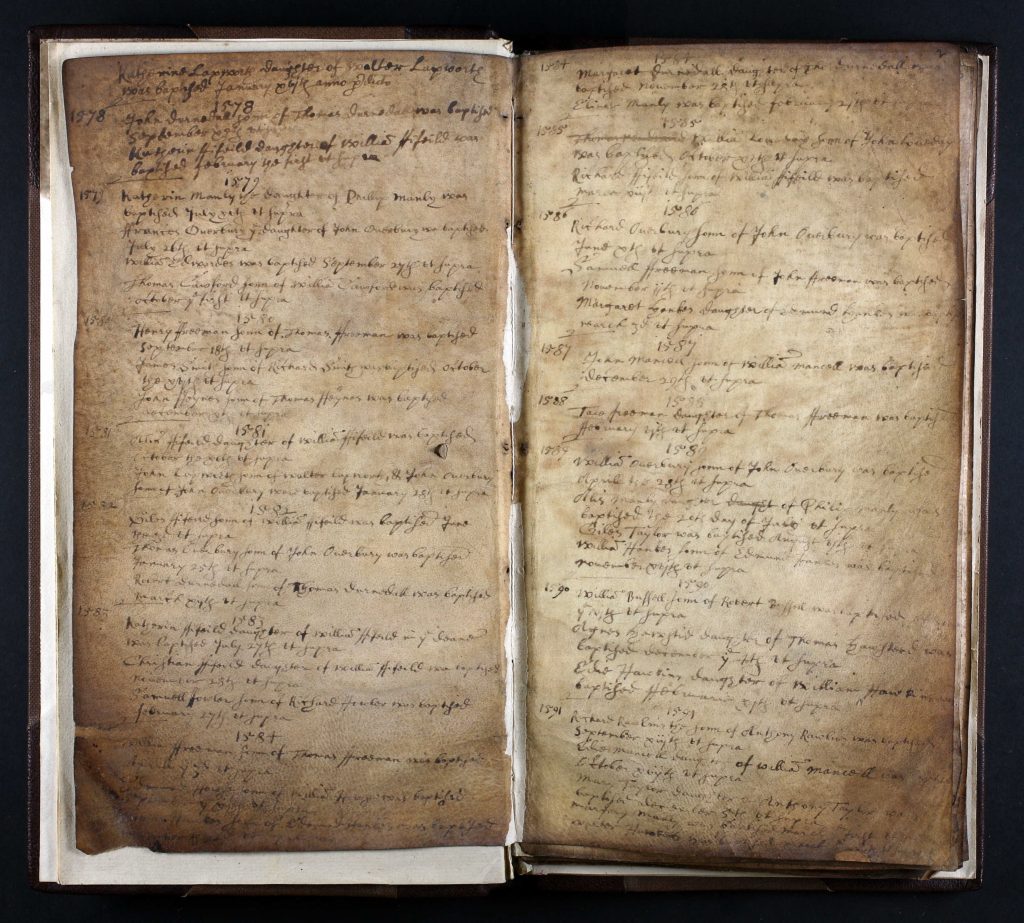
The parish transferred its old record books to the Gloucestershire County Archives for safekeeping in 2010. Records of births, marriages and deaths, together with PCC proceedings and other local history documents can be consulted at the Heritage Hub:
Clarence Row, Alvin Street, Gloucester GL1 3DW.
Researchers can find out what is held in the archives by using the archive’s online search function through which specific documents can be ordered for inspection. Visitors then have to make an appointment more than three days in advance (and apply for an “Archives Card” online before visiting.)
An inveterate archivist and typically comprehensive Victorian cataloguer, Rev John Tudor (Vicar of Turkdean 1881-1902) reviewed Turkdean’s historic registers in 1884 in order to “revise” the Parish-Register Abstract of 1831.
With his typical diligence and detail Rev Tudor wanted to rectify any impression that the registers of 1744-’54 contained “any deficiency.”
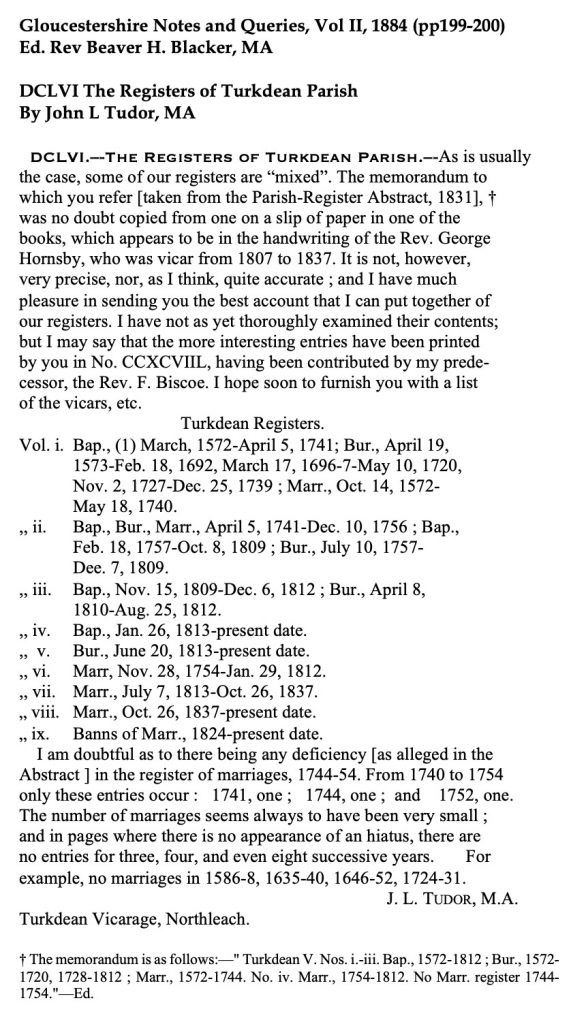
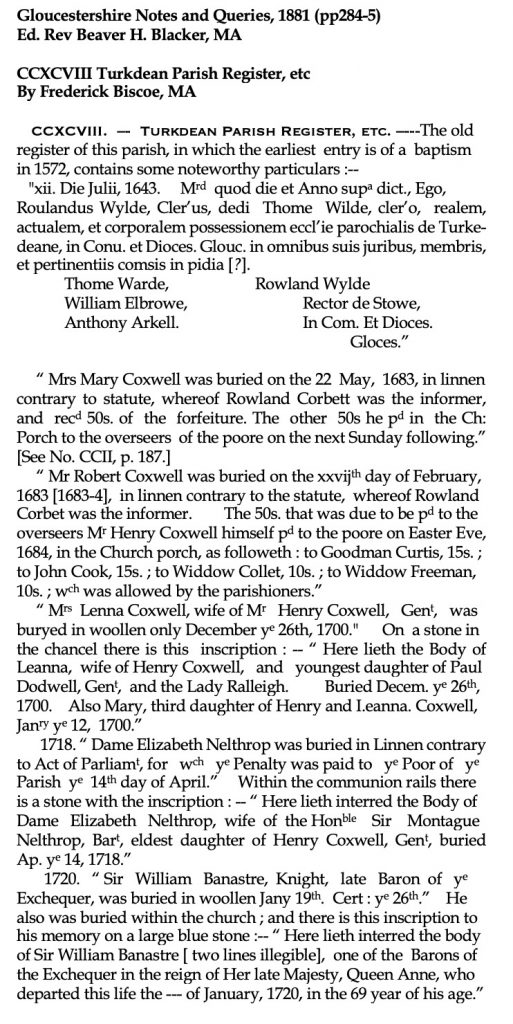
Rev Frederick Biscoe (Vicar of Turkdean 1837-’80) contributed to that most excellent of journals “Gloucestershire Notes and Queries” extracted highlights from the historic record books in his care.
After serving as Vicar for 43 years, his extracts from the archives were published posthumously in Notes and Queries in 1881, vastly assisting researchers with the perennial task of deciphering 17th and 18th century handwriting.
Having succeeded Rev Fred Biscoe as Vicar only in 1881, Rev John Tudor wasted no time in completing a thorough examination of Turkdean’s record books.
Rev Tudor transcribed entries from the earliest volumes of births, marriages and deaths and sent these in to the editor of Gloucestershire Notes and Queries for more general edification through the 1884 issue.

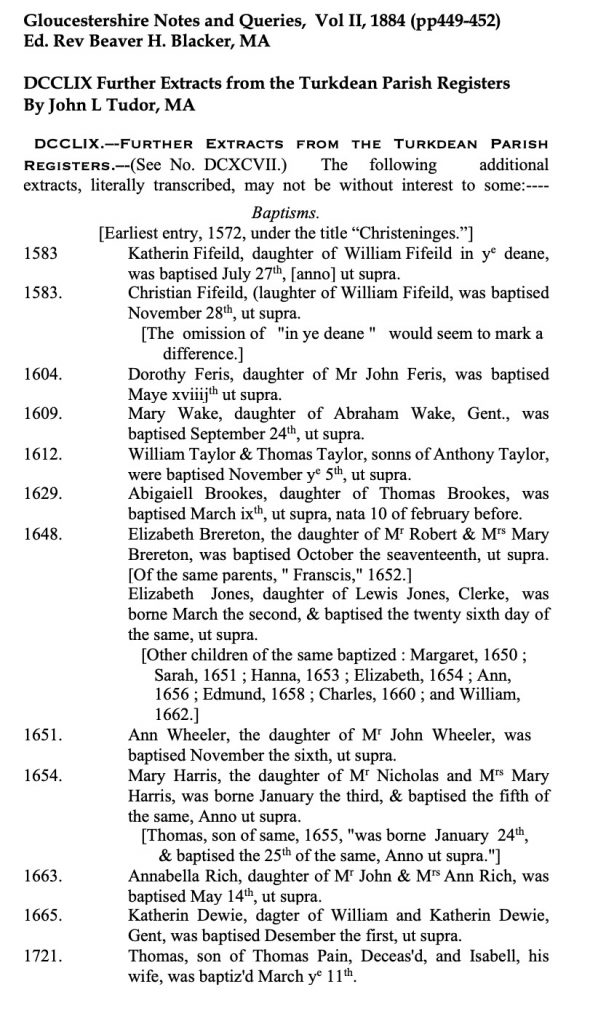
But Rev Tudor’s transcription efforts were not to be contained in just one issue. A further selection reaching back to 1583 was sent in too.
FURTHER READING
Memorials of Old Gloucestershire by Rev Peter Ditchfield FSA (1854-1930), published by George Allen 1911, pp 157-‘8
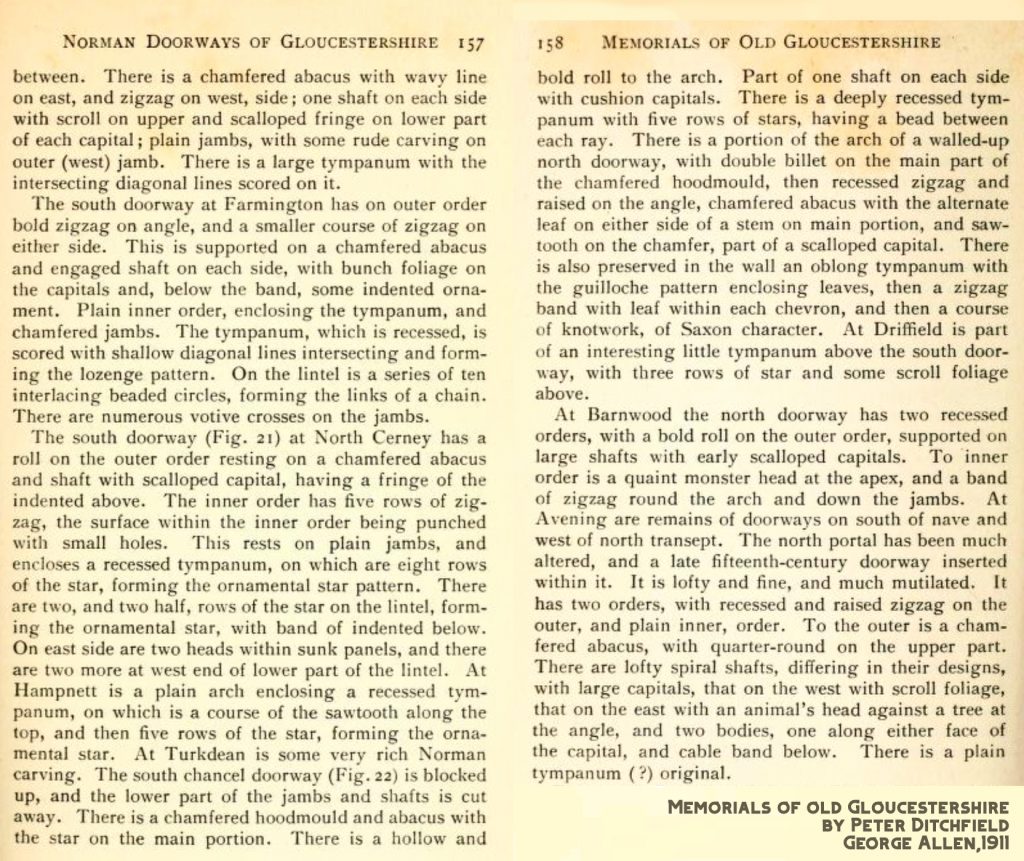
Memorials of Old Gloucestershire
By Rev Peter Ditchfield FSA (1854-1930)
Published by George Allen, 1911
An interesting description of Norman carving and the architectural “inclusions” rebuilt in to the churches’ external walls at pp 157-‘8.
A Brief Account of Turkdean Church, Northleach by Rev John Tudor, MA published in Gloucestershire Notes & Queries, October 1913
A Brief Account of Turkdean Church, Northleach
By the Rev John Tudor, MA
and Charles Lloyd Richard Tudor, architect MSA
Gloucestershire Notes & Queries
Vol X – No 89 October, 1913
A detailed account of the church refurbishment carried out in 1897 by Rev John Tudor (Vicar of Turkdean 1881-1902) together with a review of the 15th century alterations and the previous refurbishment programme carried out by Rev Frederick Biscoe in 1839.
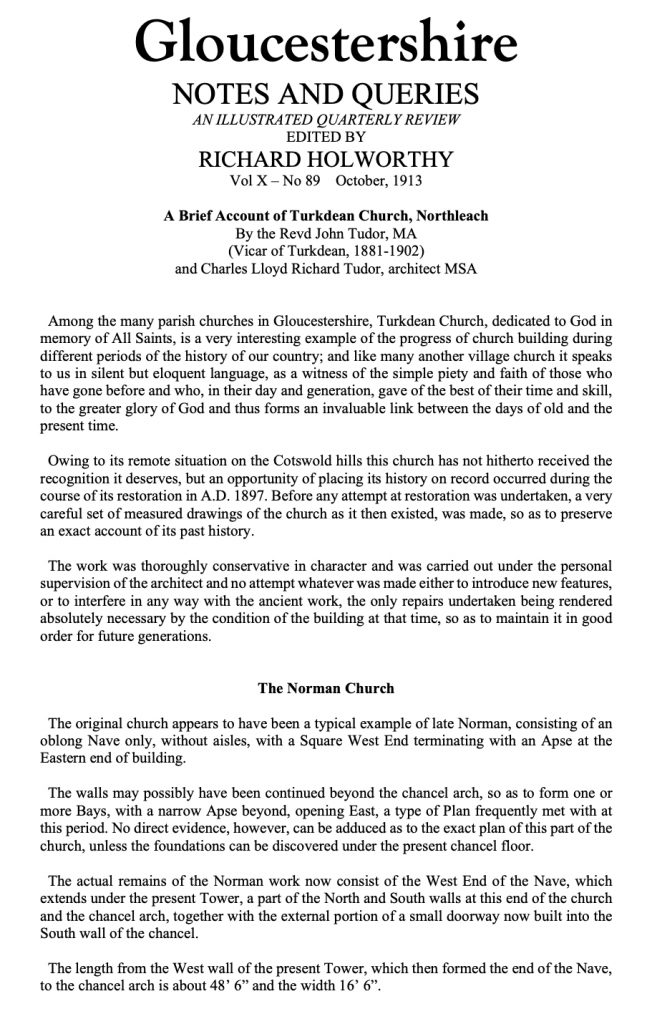
Turkdean – A Local History by John Stephenson Clark, published privately in 1981

Turkdean – A Local History
By John Stephenson Clark
Published privately, 1981
John and Enid Clark moved to Tye’s Cottage in Turkdean in 1976 when John retired. He subsequently amused himself by pulling together a rather chatty local history, perhaps slightly over-reliant on anecdote, but now an interesting reflection on how the village saw itself and its inhabitants towards the end of the 20th century.